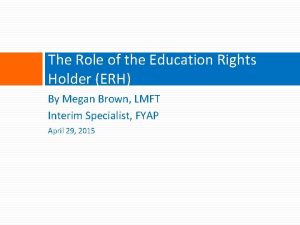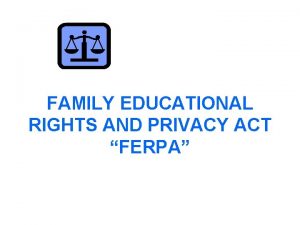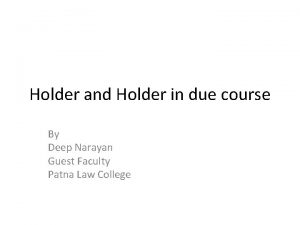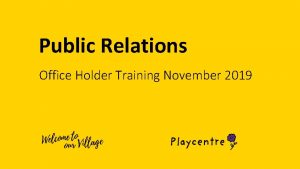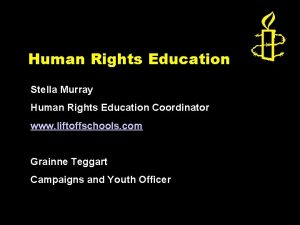The Role of the Education Rights Holder ERH


















- Slides: 18

The Role of the Education Rights Holder (ERH) By Megan Brown, LMFT Interim Specialist, FYAP April 29, 2015

Who is the Education Rights Holder (ERH)? • The default ERH is the biological parent. • A court can limit a parent’s education rights and appoint a “responsible adult” or an “educational representative” to be the ERH. • IF the court is unable to appoint an ERH and the child has been referred for a Special Education assessment or has an IEP, then the district must appoint a Surrogate parent. • A child 18 or older is their own ERH.

Who can (or can not) be the ERH? Who can be the child’s ERH? Who can NOT be the child’s ERH? • Biological Parent • Legal Guardian or Adoptive Parent • Responsible Adult that is appointed by the court (could be the foster parents or a relative caregiver) • Surrogate appointed by the district (only for students in Special Education or the Special Education process) • For children in long-term foster care, (if the biological parents rights have been limited and • • • DCFS social worker Probation officer Group home staff member District employee Employee of any agency involved in the “education or care” of the child • Anyone with a conflict of interest

How do you know who is the ERH? • Helpful documents: • JV-535 form designates the ERH • DCFS 1399 form: Notification to School of Pupil’s Foster Youth Status • Ask the caregiver and verify with CSW or Probation officer • Contact CLC Attorney or Public Defender

Empowering the Biological Parent as the ERH • Biological parents often do not know they are the ERH, because their child has been taken out of their home • If parent is trying to reunify with child (or get inhome services case closed), showing ability to address child’s educational needs can help! • Parents’ attorneys should work with their clients to and empower them to be good ERHs. • If parent unwilling or unable to act as ERH, and court limits educational rights, this hurts parent’s case.

What is the role of the ERH? • Stand in the shoes of the parent and make educational decisions based upon the child’s best interest • Investigate the child’s educational needs and determine whether or not they are being met • Communicate with the CSW prior to each hearing regarding the educational needs of the child

The ERH is the most important decision maker • The school district must afford the same rights to an ERH as to a student’s parents in making educational decisions (they act as the parent) • Only the ERH can make educational decisions on behalf of the students • The ERH’s decision is the final one- they hold more weight than the CSW, school staff, agency, group home, etc.

Example situations where the ERH is needed: • Whether or not a child should remain in his/her school of origin or transfer to a new school • Whether or not a child’s IEP is appropriate • Whether or not a child should graduate from high school under AB 167/216

The law says the ERH must be notified when: • When a school is recommending that a foster child transfer to a new school • Whether a foster child qualifies for AB 167/216, within 30 days after a child transfers into a new high school after their second year • When the child is subject to a specific disciplinary proceeding such as an expulsion hearing

FYAP Process for Identifying the ERH

Non-Emergency Situations • Process for identifying the ERH • 1. Use Data-Matching List: Determine if ERH can be determined based on the information gathered from the data-matching list. The following assumptions can be made based upon the child’s service type: • Family Maintenance (FM): Youth is living with parent or legal guardian, who is their ERH. • Permanent Placement (PP): If a youth is living with a prospective adoptive parent, then most likely the caregiver is the ERH. To be sure, follow (2)-(4) below to determine ERH. • Youth 18 and older: youth are their own ERH • Family Reunification (FR): ERH may or may not be the youth’s caregiver, follow (2)-(4) below to determine ERH.

Non-emergency situations, cont. • 2. Contact Social Worker: Send an email to the social worker asking for the ERH’s full name, relationship to the child, address and phone number. Use subject “First Request for ERH info. ” • If the social worker states the parent does not have a phone or current address, ask if they are visiting the child regularly and where to see if communication can be establish via those connections. • 3. No response from social worker: If no response is received after 2 business days, forward original email to maintain tracking and put in the subject line “Second Request for ERH info” and cc supervising social worker. • 4. No response from social worker and supervisor: If no response received after 2 business days of emailing supervising social worker, forward email trail to youth. education. support@dcfs. lacounty. gov with the subject “Third Request for ERH info. ” The education unit will then track and ensure identification of ERH.

Non-emergency situations, cont. If No ERH Appointed : • • LAUSD Suggestion: If FYAP Counselor has suggestion of who may serve as an ERH, email the social worker, supervising social worker, and Minor’s Attorney requesting an appointment of an ERH, and the relationship between the suggested person and the youth. If this is not a special education student, notify in email that a surrogate cannot be appointed instead of an ERH. No Suggestion: Email social worker, supervising social worker, and Minor’s Attorney asking for someone to be appointed that is willing and able to participate in the youth’s education. If this is not a special education student, notify in email that a surrogate cannot be appointed instead of an ERH. If ERH Inappropriate : • Email social worker, supervising social worker, and Minor’s Attorney explaining what the concerns are regarding the current ERH and follow above directions if there is or is not a suggested replacement. If this is not a special education student, notify in email that a surrogate cannot be appointed instead of an ERH. See FYAP Template Email

Emergency Situations • Examples of emergency situations: • Potential or recent home placement or school change • Pending suspension or expulsion • Potential AB 167/216 eligibility • Upcoming IEP or special education assessment request

Emergency Situations • Process: • For youth with an emergency issue, email the social worker, supervising social worker, and Minor’s Attorney, cc’ing youth. education. support@dcfs. lacounty. gov using the subject line “Immediate [nature of issue]; ERH Concern] • Use template email to discuss what is needed • Within 24 hours, counselor should receive a response.

Initial Contacts Will Make Your Job Easier! When you first start working with a foster youth, send introductory e-mails or make phone calls to the youth’s: • • Education Rights Holder Caregiver (if not the ERH) DCFS social worker or probation officer CLC attorney and/or public defender

Initial Contacts, Continued… • Connecting with you will help foster youth’s ERH’s, caregivers, social workers, probation officers, and attorneys do their jobs. • Let them know you can help by providing information they need for their reports, and working with them to address the youth’s education needs and resolve problems. • Ask them to call you about any situation that affects a youth’s education … especially a potential change in placement!

Advocacy is Key It is your responsibility to identify the ERH, make them aware of any concerns, and to advocate for the needs of the student! Thank you for advocating for our youth!
 Negotiable instrument act
Negotiable instrument act Holder in due course example
Holder in due course example Holder in due course negotiable instrument
Holder in due course negotiable instrument Educational rights holder
Educational rights holder Negative rights vs positive rights
Negative rights vs positive rights Riparian doctrine
Riparian doctrine Characteristics of rights
Characteristics of rights Legal rights vs moral rights
Legal rights vs moral rights Positive vs negative rights
Positive vs negative rights Negative rights vs positive rights
Negative rights vs positive rights Negative rights vs positive rights
Negative rights vs positive rights Positive rights and negative rights
Positive rights and negative rights What is web role and worker role in azure
What is web role and worker role in azure Krappmann symbolischer interaktionismus
Krappmann symbolischer interaktionismus Statuses and their related roles determine the structure
Statuses and their related roles determine the structure Family educational rights and privacy act
Family educational rights and privacy act Pearson education inc all rights reserved
Pearson education inc all rights reserved Pearson education inc. all rights reserved
Pearson education inc. all rights reserved Pearson education inc. all rights reserved
Pearson education inc. all rights reserved



